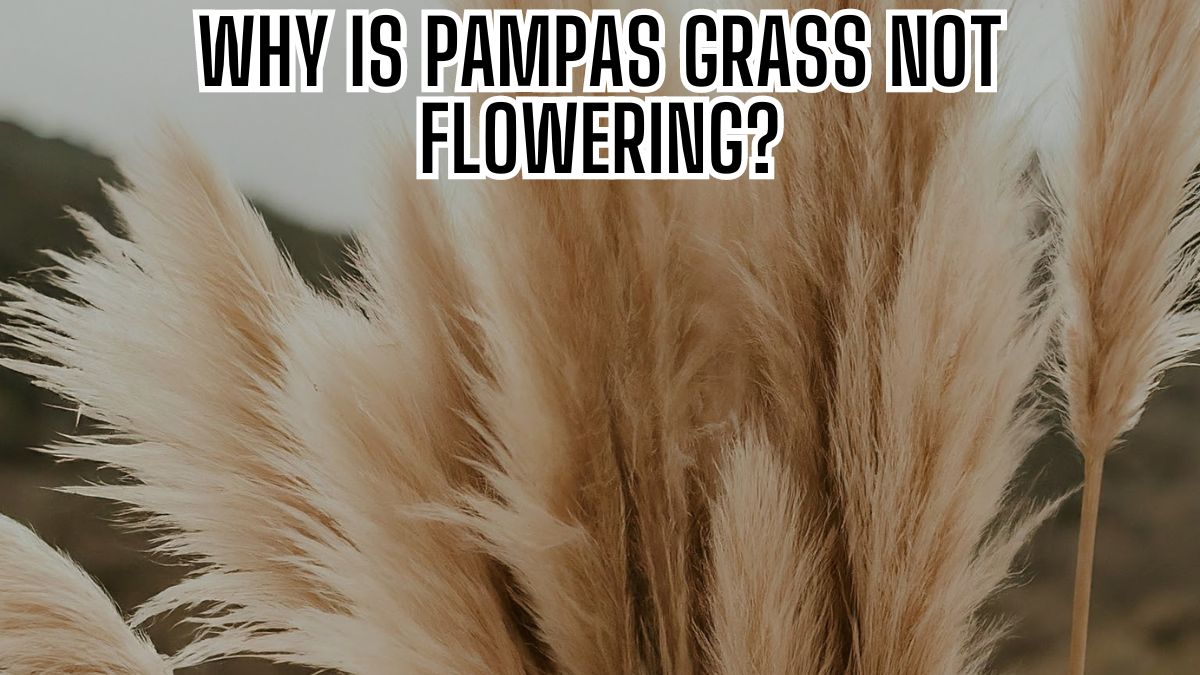Have you noticed that Why is pampas grass not flowering? This can be a common problem for many people who love gardening. In this blog post, we’ll talk about why this might be happening and give you some easy tips to help your pampas grass make those pretty, fluffy flowers. So, if you’re new to gardening or have been doing it for years, keep reading to learn more about how to get your pampas grass to flower.
Understanding Pampas Grass
Pampas grass, also known as Cortaderia selloana, is a tall grass native to South America. It’s famous for its large, feathery plumes, which are often white but can also be pink or silver. These plumes are actually the flowers of the pampas grass, and they usually appear in late summer or early fall.
The flowers of pampas grass are one of its most attractive features. They add a unique beauty to any garden with their tall, fluffy appearance. But these flowers aren’t just pretty to look at. They’re also important for the health of the pampas grass. When the grass flowers, it’s a sign that it’s healthy and getting the right amount of sunlight and nutrients.
So, if your pampas grass isn’t flowering, it might mean that it’s not as healthy as it could be. But don’t worry, there are things you can do to help it flower, which we’ll talk about in this blog post. So, keep reading to learn more about pampas grass and how to care for it.
Reasons why pampas grass is not flowering
The common reasons why your pampas grass might not be flowering:
Environmental Conditions
- Insufficient Sunlight: Pampas grass loves the sun. If it’s not getting enough sunlight, it might not flower. Make sure your pampas grass is planted in a spot where it gets plenty of sun throughout the day.
- Inappropriate Climate: Pampas grass thrives in warmer climates. If you live in a region with cold temperatures, your pampas grass might struggle to flower.
Soil Quality and Nutrition
- Poor Soil Quality: Pampas grass needs well-draining soil. If the soil is too heavy or waterlogged, it can prevent the grass from flowering.
- Lack of Essential Nutrients: Like all plants, pampas grass needs certain nutrients to grow and flower. If your soil lacks these nutrients, your pampas grass might not flower. You might need to add a fertilizer to your soil.
Watering Practices
- Overwatering or Underwatering: Pampas grass needs the right amount of water to flower. Too much or too little water can prevent it from flowering. Make sure you’re watering your pampas grass correctly.
Pruning and Maintenance
- Improper Pruning Techniques: If you’re not pruning your pampas grass correctly, it might not flower. Make sure you’re cutting back the old growth at the right time of year.
- Lack of Maintenance: Pampas grass needs regular care to stay healthy and flower. This includes removing dead leaves and plumes and checking for pests.
Solutions and Tips to Encourage Flowering
Here are some solutions and tips to encourage your pampas grass to flower:
Improving Sunlight Exposure
- Adjusting Planting Locations: If your pampas grass isn’t getting enough sunlight, consider moving it to a sunnier spot in your garden. Remember, pampas grass loves the sun!
- Ensuring Adequate Light Levels: Make sure your pampas grass is getting at least 6 hours of direct sunlight each day. If it’s in a shady spot, it might not flower.
Enhancing Soil Quality
- Soil Testing and Amendments: Test your soil to see if it has the right nutrients for pampas grass. If it doesn’t, you can add amendments like compost or manure to improve the soil quality.
- Fertilization Tips: Use a balanced fertilizer to provide your pampas grass with the nutrients it needs to flower. Follow the instructions on the fertilizer package to avoid over-fertilizing.
Optimizing Watering Practices
- Establishing a Consistent Watering Schedule: Pampas grass likes consistent watering. Try to water it regularly, but don’t overwater. The soil should be moist, but not waterlogged.
- Avoiding Waterlogging: Make sure your pampas grass is planted in well-draining soil. If the soil is too wet, it can prevent the grass from flowering.
Proper Pruning Techniques
- When and How to Prune Pampas Grass: Prune your pampas grass in late winter or early spring, before new growth starts. Cut back the old growth to about a foot above the ground.
- Benefits of Regular Maintenance: Regularly removing dead leaves and plumes can help your pampas grass stay healthy and flower. Also, check for pests and treat them promptly to keep your pampas grass in good shape.
Seasonal Care for Pampas Grass
Pampas grass, known for its towering plumes and feathery texture, is a low-maintenance plant that thrives in a variety of climates. However, like all plants, it requires some seasonal care to stay healthy and vibrant. Here’s a simple guide on how to care for your pampas grass throughout the year.
Spring
Spring is the time for new growth. Start by pruning your pampas grass. Cut back the old foliage to about a foot from the ground to make room for new shoots. This is also a good time to fertilize your plant. Use a slow-release, balanced fertilizer to provide the necessary nutrients for growth.
Summer
In the summer, pampas grass needs plenty of water. Water deeply once a week, or more often during periods of drought. Watch out for pests and diseases, and treat them promptly if they appear.
Autumn
Autumn is when pampas grass shows off its spectacular plumes. There’s not much to do in terms of care during this season, but you can harvest the plumes if you wish to use them for decoration.
Winter
In winter, pampas grass goes dormant. There’s no need for watering or fertilizing during this time. However, you might want to tie up the grass to prevent it from being damaged by heavy snow.
Conclusion
In conclusion, pampas grass not flowering can be attributed to a variety of factors, including insufficient sunlight, inadequate nutrients, improper watering, or simply the plant’s age. Understanding these factors and adjusting your care practices accordingly can help ensure your pampas grass blooms beautifully. Remember, patience is key when it comes to gardening. With the right conditions and care, your pampas grass should eventually reward you with its stunning plumes.
FAQs
Here are some frequently asked questions (FAQs):
- Why is my pampas grass not producing plumes? Pampas grass may not produce plumes if it’s not receiving enough sunlight, if it’s too young (it usually starts flowering after 2-3 years), or if it’s not getting the right nutrients. Overwatering can also prevent blooming.
- How much sunlight does pampas grass need to flower? Pampas grass thrives in full sun. It needs at least six hours of direct sunlight each day to flower well. If your pampas grass is in a shaded area, consider moving it to a sunnier spot.
- What kind of soil is best for pampas grass to bloom? Pampas grass prefers well-draining soil. It can tolerate a wide range of soil types, from sandy to clay, as long as the soil doesn’t stay waterlogged. Adding compost or a slow-release fertilizer can provide the nutrients needed for blooming.
- How long does it take for a pampas grass plant to start flowering? Pampas grass typically starts flowering in its third year. If your plant is younger than this, it may simply not be mature enough to produce flowers yet. Patience is key!


